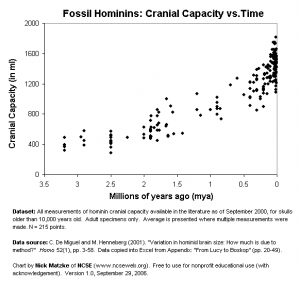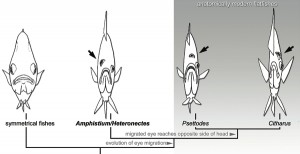“Evidences for Darwin’s second expectation – of stratomorphic intermediate species – include such species as Baragwanathia (between rhyniophytes and lycopods), Pikaia (between echinoderms and chordates), Purgatorius (between the tree shrews and the primates), and Proconsul (between the non-hominoid primates and the hominoids). Darwin’s third expectation – of higher-taxon stratomorphic intermediates – has been confirmed by such examples as the mammal-like reptile groups between the reptiles and the mammals, and the phenacdontids between the horses and their presumed ancestors. Darwin’s fourth expectation – of stratomorphic series – has been confirmed by such examples as the early bird series, the tetrapod series, the whale series, the various mammal series of the Cenozoic (for example, the horse series, the camel series, the elephant series, the pig series, the titanothere series, etc.), the Cantius and Plesiadapus primate series, and the hominid series. Evidence for not just one but for all three of the species level and above types of stratomorphic intermediates expected by macroevolutionary theory is surely strong evidence for macroevolutionary theory. Creationists therefore need to accept this fact. It certainly CANNOT said that traditional creation theory expected (predicted) any of these fossil finds.” (link)
Who do you think authored this quote? Richard Dawkins? Carl Sagan? Some run-of-the-mill anti-creationist science writer? No. The person who wrote this is Dr. Kurt Wise, a creationist paleontologist who studied under Stephen Jay Gould at Harvard University. This is significant, as this shows that even fossil experts who do not like evolution acknowledge that the fossil record strongly supports it. Nick Matzke created a graph of hominid skulls (the group humans belong to) that I think beautifully illustrates the point:
Note that Matzke’s graph is derived from material that has been published in peer-reviewed, scientific journals.
The logic behind every argument from transitional forms is like this: if life comes from life, the homonids that existed half a million years ago must be descended from homonids that existed three million years ago. It follows that between those times homonids must have existed that were transitional between the the early and late forms (prediction). The fossil record confirms this prediction, which greatly strengthens the theory of evolution.
The evidence from the fossil record is not only vast but vastly interesting. The Picasso fish has both its eyes on the right side of its head, and there are fossils that show its evolutionary history:
A bee fossilized in amber (kind of like the mosquito on Jurassic Park) showed characteristics of both wasps and bees, direct evidence of the latter group having evolved from the former (reported in Science).
There are many more beautiful fossils and even detailed sequences (like the homonin sequence) that support evolution. I’d recommend Evolution: What the Fossils Say and Why it Matters if you’d like to look at them yourself. There are plenty of resources online: the whale fossil series, the tetrapod series, the horse fossil series, among others.
Conclusion
How likely is all of this fossil evidence if evolution happened? How likely is it if it did not? Under the theory of evolution, it is certain (or at least very nearly certain) that we should find the type of evidence we have. We might not be able to predict the exact fossils that come out of the ground, but evolution leads us to expect fossils with certain characteristics, and these have been found in great abundance. I’ll say that, modestly, evolution predicts the evidence we have with 90% certainty.
How well does spontaneous generation/creationism predict the evidence? To be honest, I’m not sure how things like this could be explained or why they might have existed in the past under such theories. One thing is for sure: The spontaneous generation theory does not give you any reason at all to think that these things would exist. So the fossil evidence isn’t “more likely than not” under the theory of spontaneous generation, which means that we can’t assign the probability as being greater than 50%. Arguably, the fossil evidence we have is extraordinarily unlikely if creationism/spontaneous generation is true, but to be generous, we could estimate it as being exactly 50% likely. This doesn’t mean that the theory of creationism is now 50% likely, it only means that the fossil evidence is no more than 50% likely if creationism is true. Figuring out where this prediction leaves the final probability of creationism will be discussed at the end of this series.
To Be Continued…


